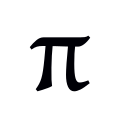See also: Π [U+03A0 GREEK CAPITAL LETTER PI], ∏ [U+220F N-ARY PRODUCT], ㄇ [U+3107 BOPOMOFO LETTER M], ㄫ [U+312B BOPOMOFO LETTER NG], 丌 [U+4E0C CJK UNIFIED IDEOGRAPH-4E0C], 兀 [U+5140 CJK UNIFIED IDEOGRAPH-5140], ㅠ [U+3160 HANGUL LETTER YU], and Appendix:Variations of "p"
 | ||||||||
| ||||||||
Character variations
| ||||||||
Translingual
editSymbol
editπ
- (mathematics) Pi, an irrational constant representing the ratio of the circumference of a circle to its diameter; approximately 3.14159265.
- (particle physics) pion, pi meson
- (mathematics) homotopy group
- (mathematics) prime-counting function
- (UPA) A voiced labial click consonant (IPA [ɡ͜ʘ]).
- (phonetics, rare) A voiceless labiodental plosive (p̪).
See also
editAncient Greek
editEtymology
editDerived from its majuscule counterpart Π.
Letter
editπ • (p) (lowercase, uppercase Π)
- Lower-case pi (πεῖ), the 16th letter of the ancient Greek alphabet. It represented the voiceless unaspirated bilabial plosive /p/. It is preceded by ο and followed by ρ.
Derived terms
editSee also pi
See also
editGreek
editLetter
editπ • (p) (lowercase, uppercase Π)
- The lower case letter pi (πι), the 16th letter of the modern Greek alphabet.
See also
editCategories:
- Character boxes with images
- Greek and Coptic block
- Greek script characters
- Mathematical Alphanumeric Symbols block
- Mathematical notation symbols
- Translingual lemmas
- Translingual symbols
- mul:Mathematics
- mul:Particle physics
- UPA symbols
- mul:Phonetics
- Translingual terms with rare senses
- Ancient Greek lemmas
- Ancient Greek letters
- Greek lemmas
- Greek letters